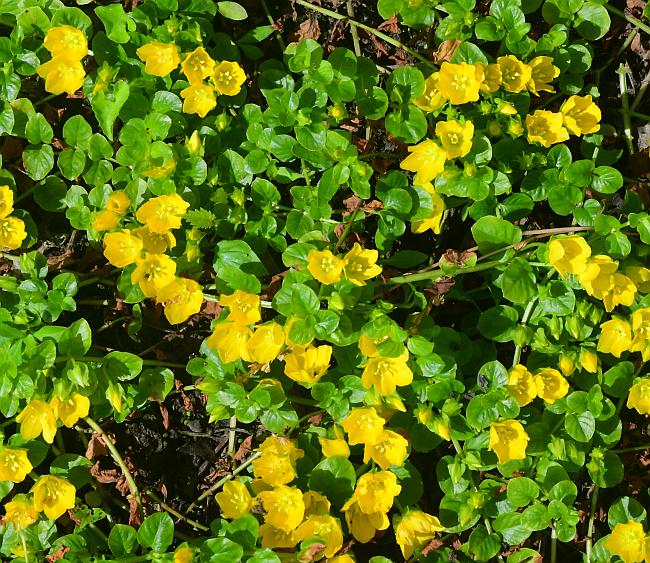Lysimachia nummularia L.
Moneywort

Introduced
CC = *
CW = -3
MOC = 41
© SRTurner
Lysimachia nummularia L.Moneywort | |
 |
Introduced CC = * CW = -3 MOC = 41 |
© SRTurner |
|
Family - Primulaceae Habit - Perennial forb, lacking rhizomes. Stems - Prostrate, creeping, 40 cm or longer, relatively slender, multiple from the base, sometimes mat-forming, rooting at the nodes, glabrous, but usually developing scattered, minute, gland-dots with age.
Leaves - Opposite, simple, petiolate. Petioles well-differentiated, 0.2-0.5 cm long, somewhat flattened, narrowly winged, glabrous except for scattered, minute, gland-dots or punctations. Leaf blades circular or nearly so, 1.0-2.5 cm, the bases rounded, rounded or very broadly angled to a bluntly pointed tip, the margins entire, the surfaces with scattered, minute, glandular dots, these orangish brown to reddish brown, sometimes relatively faint, otherwise glabrous, green to yellowish green. Veins of the leaves impressed above, expressed below, secondary veins faint but often evident.
Inflorescence - Solitary or paired axillary flowers, the flower stalks 1-3 cm long, glabrous.
Flowers - Calyces 5-lobed, the lobes 6-9 mm long, narrowly ovate to ovate with a cordate base, gland-dotted, with a slightly thickened midvein. Corollas usually 5-lobed, the lobes 12-15 mm long, obovate, rounded or broadly angled to a bluntly pointed tip, the margins usually slightly uneven or toothed toward the tip, yellow, moderately to densely glandular but lacking reddish markings on the upper surface toward the base, both surfaces with scattered, reddish purple to nearly black glandular spots and short lines. Stamens shorter than the corollas, the filaments 3-5 mm long, slightly unequal, fused basally into a short tube, glandular-hairy. Staminodes absent. Styles 4-5 mm long. Ovary superior, green, glabrous, globose, 1.2 mm in diameter.
Fruits - Usually not produced. Flowering - May - August. Habitat - Streambanks, pond margins, sloughs, acid seeps, bottomland forests, lawns, railroads, roadsides, moist disturbed areas. Also cultivated. Origin - Native to Europe. Other info. - This weedy yet attractive species can be found scattered throughout most of Missouri. The plant is an escape from lawns and gardens and is now well established in the state. It also occurs throughout much of the Midwest and Northeast, and ranges into Canada. It is easily recognized by its prostrate stems with opposite pairs of round leaves, growing in moist habitats. It does not often flower, which is unfortunate because they can be quite showy in large numbers. Plants in Missouri also do not produce fruits, but rather reproduced vegetatively from bits of stem transported by water. Photographs taken at Reifsnider Conservation Area, Warren County, MO, 5-26-2012, and Riverfront Park, Washington, Franklin County, MO, 5-28-2020 (SRTurner). |